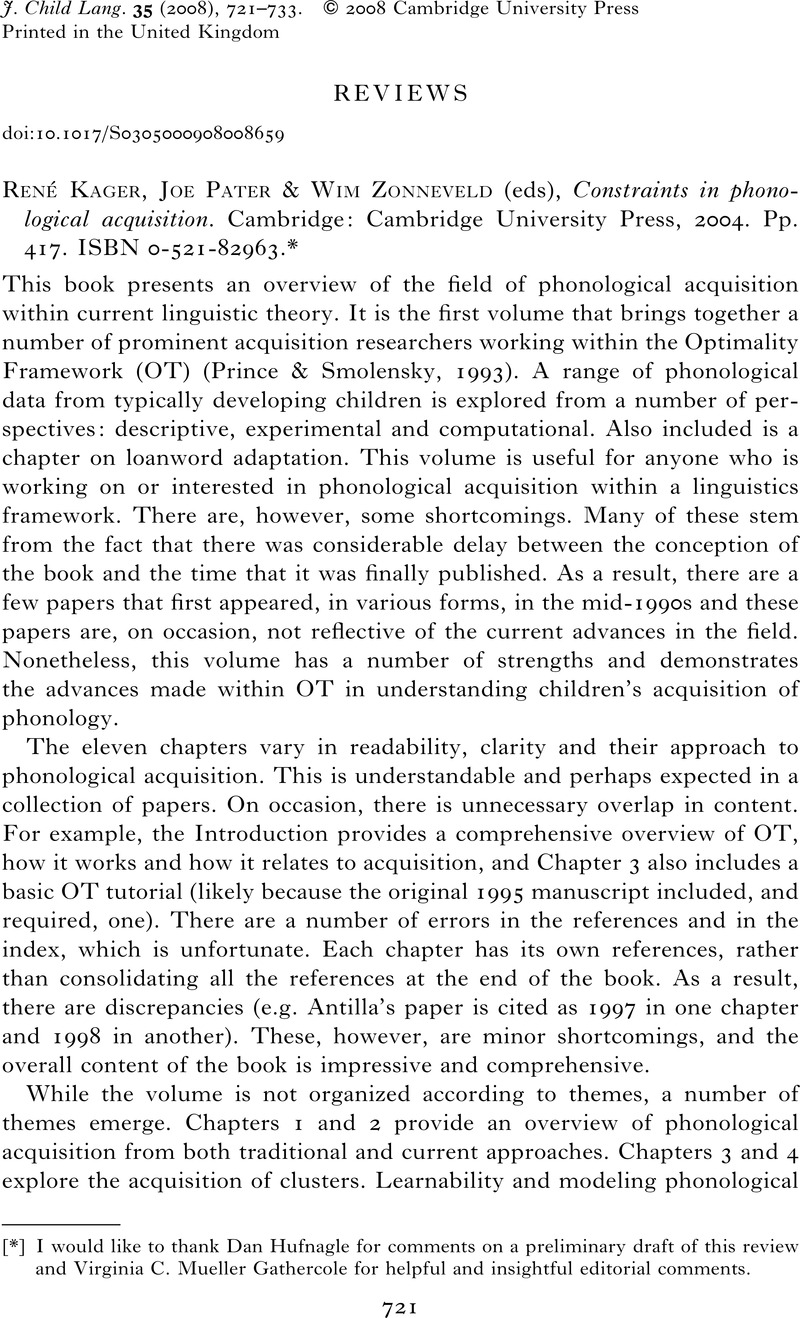No CrossRef data available.
Article contents
René Kager, Joe Pater & Wim Zonneveld (eds), Constraints in phonological acquisition. Cambridge: Cambridge University Press, 2004. Pp. 417. ISBN 0-521-82963.*
Published online by Cambridge University Press: 27 June 2008
Abstract
An abstract is not available for this content so a preview has been provided. Please use the Get access link above for information on how to access this content.

- Type
- Reviews
- Information
- Copyright
- Copyright © 2008 Cambridge University Press
References
Barlow, J. (2001). The structure of /s/ clusters: evidence from a disordered system. Journal of Child Language 28, 291–324.CrossRefGoogle Scholar
Boersma, P. (1998). Functional phonology: formalizing the interactions between articulatory and perceptual drives. The Hague: Holland Academic Graphics.Google Scholar
Chomsky, N. & Halle, M. (1968). The sound pattern of English. New York: Harper and Row.Google Scholar
Curtin, S. (2002). Representational richness in phonological development. Unpublished PhD dissertation, University of Southern California.Google Scholar
Dinnsen, D., McGarrity, L., O'Connor, K. & Swanson, K. (2000). On the role of sympathy in acquisition. Language Acquisition 8, 321–61.CrossRefGoogle Scholar
Gierut, J. (1999). Syllable onsets: clusters and adjuncts in acquisition. Journal of Speech, Language, and Hearing Research 42, 708–26.CrossRefGoogle ScholarPubMed
Hale, M. & Reiss, C. (1998). Formal and empirical arguments concerning phonological acquisition. Linguistic Inquiry 29, 656–83.CrossRefGoogle Scholar
Hayes, B. (1999). Phonetically-driven phonology: the role of Optimality Theory and inductive grounding. In Darnell, M., Moravscik, E., Noonan, M., Newmeyer, F. & Wheatly, K. (eds) Functionalism and formalism in linguistics, Volume I: General papers, 243–85. Amsterdam: John Benjamins.CrossRefGoogle Scholar
Prince, A. & Smolensky, P. (1993). Optimality Theory: constraint interaction in generative grammar. MS., Rutgers University, New Brunswick and University of Colorado, Boulder. [Technical report 2, Rutgers University Center for Cognitive Science.]Google Scholar
Smith, N. (1973). The acquisition of phonology: a case study. Cambridge: Cambridge University Press.Google Scholar
Stager, C. L. & Werker, J. F. (1997). Infants listen for more phonetic detail in speech perception than in word learning tasks. Nature 388(6640), 381–82.CrossRefGoogle ScholarPubMed
Tesar, B. & Smolensky, P. (1998). Learnability in Optimality Theory. Linguistic Inquiry 29, 229–68.CrossRefGoogle Scholar
Velleman, S. & Vihman, M. M. (2002). The optimal initial state. Ms. University of Massachusetts and University of Wales, Bangor. Rutgers Optimality Archive (ROA) 552–1002 (http://roa.rutgers.edu/).Google Scholar
Werker, J. F. & Curtin, S. (2005). PRIMIR: a developmental model of speech processing. Language Learning and Development 1(2), 197–234.CrossRefGoogle Scholar
Zamuner, T., Gerken, L. & Hammond, M. (2004). Phonotactic probabilities in young children's speech production. Journal of Child Language 31, 515–37.CrossRefGoogle ScholarPubMed




